Tajik Chakan Conquers the World of Modern Fashion
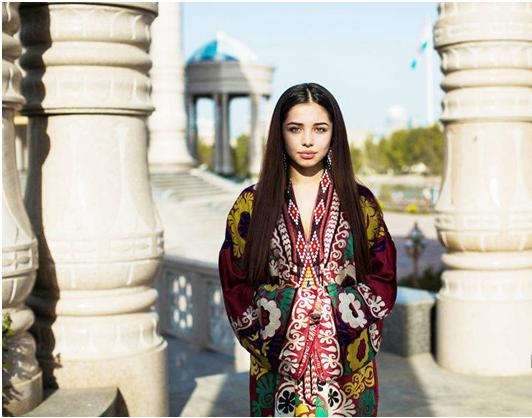
DUSHANBE, 18.01.2019. (NIAT Khovar) – The Tajik national embroidery Chakan was inscribed on the World Representative List of the Intangible Cultural Heritage of Humanity. All documents for the nomination were handed over to UNESCO five years ago. But, the ancient bright design took its place of honor only recently.
Ancient Chakan inmodern fashion
Tajik designer KhurshedSattorov has long been known abroad. He is a regular participant of various shows. His collection included theChakan at UNESCO’s annual session, which was held in Mauritius. The jury liked the bright ornament and the style of the hand embroidery of the ancient pattern and its interpretation in a modern manner.
Sattorov says that such an image emphasizes femininity and style. But most importantly, his Chakan collection is a tribute to our ancestors. After all, it promotes the cultural heritage of Tajiks not only within the country, but also in the fashion world.
The Tajik designer personally draws sketches and complements ancient patterns with his own, but without changing the canons of the existing ornament. He has long studied the works of eminent masters.
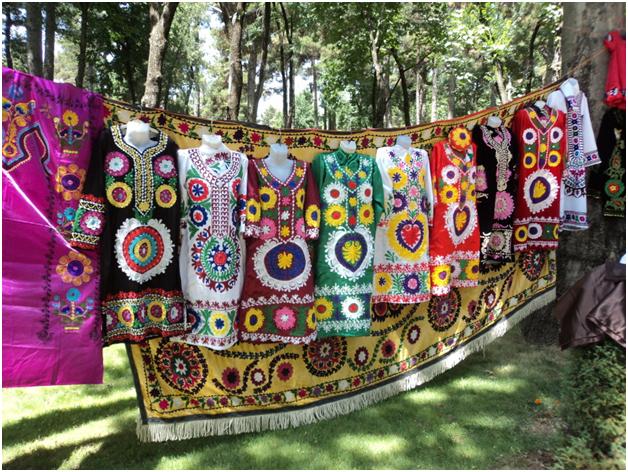
He was inspired not only by the love for this pattern buthad previously mastered the embroidery technique and learned its semantic meaning. He had also paid much attention to the colors of the canvas and threads.
“White color should always be present in the ornament, to inspire hope for all things bright, kind and happy. The red color is a sign of fire, and protection from evil,” says Sattorov.
Chakan’s history
Previously, the Chakan embroidery was mainly used in the mountainous regions of Tajikistan. Today, the ornament has spread to all regions of the republic. In the Pamir region, it is embroidered on white fabric. A combination of two colors is used in the north, for example, a yellow cloth and a black pattern. People in the west choose a green background. But in the south, in the Khatlon province, preference is given to the red background and bright threads. The south, or rather the city of Kulob, is considered the birthplace of Chakan. Perhaps that is why here it is so colorful, reminiscent of early spring and hot summer.
Though no one knows exactly when the Chakan originated, historians place its origins in the period of Zoroastrianism, linking it with the cult of the sun and the personification of the four principles. After all, the basis of the pattern is the outline of a circle. In general, the drawing looks like the sun radiating its rays or a blooming flower. On closer inspection the Chakan includes other elements besides the sun, such as water symbolizing birth, fertility and freshness. Blue wavy lines represent longevity. The image of pepper scares away evil spirits and protects from the evil eye.
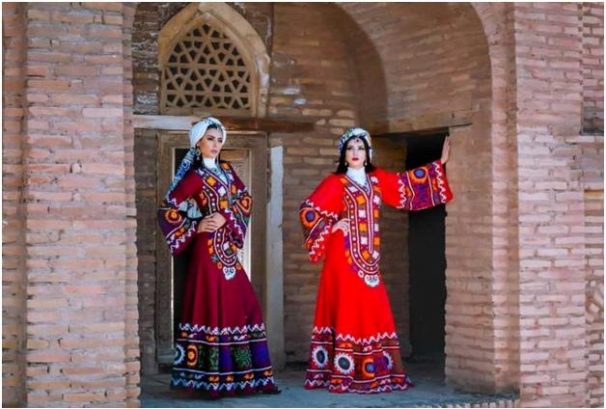
“It is important to understand the meaning of the patterns. After all, everything should be in one picture and in harmony with each other. Otherwise, it is not a Chakan and not intricate embroidery. This work is time-consuming and requires perseverance and patience. A pair of three-dimensional patterns on the dress can take three or four days, but fora panel two weeks may not be enough,”says a resident of Kulob Obidamo Burhonova.
Usually two craftswomen are engaged in making a Chakan. While ObidamoBurhonova embroiders, her daughter drawsthe pattern.
Customs
The loose and wide-sleeved Chakan dress is popular in Tajikistan, especially if it is made by hand. It is believed that if the dress is made with the soul and power is embedded in the ornament, the Chakan will act as a talisman. The Chakan design is found on skullcaps, bags, fabrics, paintings, dishes and bedspreads.
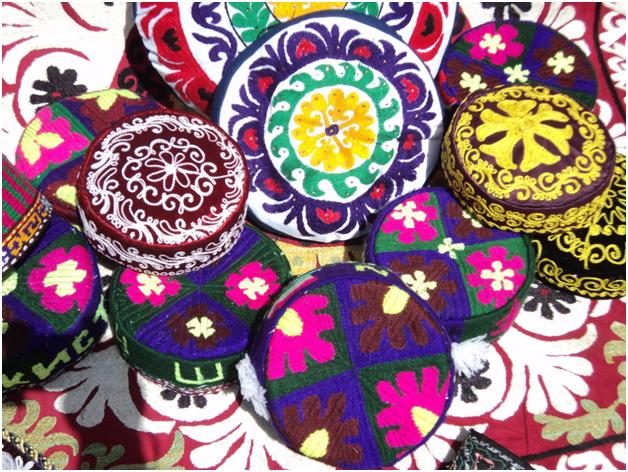
In the old days, they wide sleeves were used as fans in hot days. Now such outfit can be seen more often only on stage.Today, women prefer tight-fitting, shorter clothes.
In Tajikistan, Chakan is associated not only with embroidery, but also with dancing. The moving should be bright and dynamic as in the homeland of Chakan, in the Khatlonprovince.
Women also used the wide embroidered sleeves of Chakan dresses as pockets and during festivities would fill them with sweets, to be later handed out to children.When a girl was born in Kulob, her mother or grandmother would embroider a sleeve on the fabric from which the future dress would be made. When the girl was older, she herself wouldcomplete the dress and the ornament. Relatives believed that by doing this the girl would grow up to be healthy and prosperous.
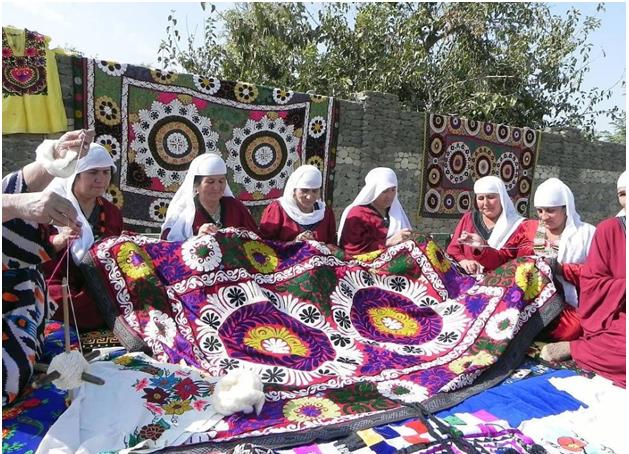
A Chodari, which is a two-meter squared decorated fabric, is made prior to the wedding. During the wedding the fabricis held over the young pair when a young bride is escorted to the groom’s house. This tradition continues to this day. The Chodari can take years to embroider.
No matter how modern and expensive the wedding dress is, the young bride always wears a dress with a Chakan pattern in the house of the groom’s parents in the first days after the wedding. It can be both white and red.
Chakan Day — the future of Chakan
Today, artisan fairs are often held in Tajikistan, where the Chakan isalways on display. In order to understand the importance of Chakan in Tajik culture, a new holiday, Chakan Day, was declared. The day falls near the middle of summer, so that the ornament can show all its strength and colors under the bright summer sunlight.











 Tajikistan to host Chinese Culture Days
Tajikistan to host Chinese Culture Days National Museum of Tajikistan to Exhibit Artifacts at International Exhibition in China
National Museum of Tajikistan to Exhibit Artifacts at International Exhibition in China Filmmakers from 20 Countries to Participate in the International “Toji Somon” Film Festival
Filmmakers from 20 Countries to Participate in the International “Toji Somon” Film Festival Opening Ceremony of the Days of Mongolian Culture Held in Tajikistan
Opening Ceremony of the Days of Mongolian Culture Held in Tajikistan President of Mongolia Ukhnaagiin Khurelsukh Explores the History of the Tajik People at the National Museum of Tajikistan
President of Mongolia Ukhnaagiin Khurelsukh Explores the History of the Tajik People at the National Museum of Tajikistan Mongolian Culture Days to Take Place in Tajikistan
Mongolian Culture Days to Take Place in Tajikistan Ten New Historical and Cultural Sites Discovered in Tajikistan
Ten New Historical and Cultural Sites Discovered in Tajikistan Six Tajik Documentaries to Be Broadcast on Chinese Television
Six Tajik Documentaries to Be Broadcast on Chinese Television Tajikistan Submits Five New Nominations for Inclusion in the UNESCO World Heritage List
Tajikistan Submits Five New Nominations for Inclusion in the UNESCO World Heritage List Tajik Gymnasts Win 15 Medals at International Rhythmic Gymnastics Competition
Tajik Gymnasts Win 15 Medals at International Rhythmic Gymnastics Competition Tajikistan’s Contribution to Cultural Heritage Preservation in the Era of Globalization Presented in Kazakhstan
Tajikistan’s Contribution to Cultural Heritage Preservation in the Era of Globalization Presented in Kazakhstan














